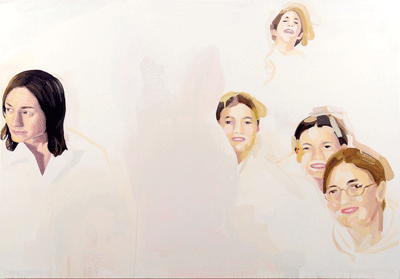Walker Art Center, Sabes JCC offer exhibits by Jewish artists from the Twin Cities and around the country
By DORIS RUBENSTEIN
Jewish artists are having a heyday currently on the west side of the Mississippi River. The challenge for local Jewish art aficionados is finding time to see it all.
For those east of the Mississippi, starting closer to home at the Walker Art Center might be a good idea. Frank Gaard is being honored there with a major retrospective of his work, which will run through May 6.
Frank Gaard: Poison & Candy takes us through the development of Gaard’s unique style and subject matter over 40 years. His work walks the line between art, illustration and comic book; my eye and brain tie his style and diverse output to that of R. Crumb. Indeed, Gaard led the counter-cultural arts movement centered on the now-defunct Artpolice, a publication that combined art with current political commentary and a large dollop of Gaard’s own philosophical musings.
Gaard converted to Judaism in 1982, an event that ignited his interest in the Kabbala. His focus has been on the sephiroth, a graphic representation of physical and metaphysical realms, which found its way into the artist’s experiments with different styles and media, some of which are included in the retrospective.
Despite Gaard’s playfulness, this show is not for the kinderlach (children). There are a few of Gaard’s more erotic paintings — playful, but graphic — in the exhibition that might make this show off-limits for very protective parents.
No matter on which side of the river you live, the show currently on display at the Sabes JCC’s Tychman Shapiro Gallery will not offend. Fitting In features the works of three artists with distinct styles using very different media to explore the theme of community: how it is formed, and the roles of individuals facing society’s rules and customs.
Local gallerygoers will recognize Scott Seekins, who appears as his enigmatic self in a series of photographs taken along Hennepin Avenue next to the Walker Art Center. At first glance, all appear to show Seekins as a homeless man, holding signs that generally announce, “Out of work… please help” or the like. Wrong. The signs, in English and Hebrew, contain philosophical messages or quotations from famous Jews such as Anne Frank.
Clearly, Seekins is the model, producer and director of the photography, but as such leaves the actual lens-clicking to others, such as the Tychman Shapiro Gallery’s director, artist Robin Awend.
Minnesotan Shana Kaplow offers paintings of people in places and apart from places. In the latter, her paintings “Left” and “Old Song,” the empty spaces clearly leave room for images of people who were in the place depicted only in our minds and the mind of the artist, or are no longer there; or they could be in the space, but are not. Their ghostly absences are all that is visible to the gallery guest.
 “Left” by Shana Kaplow is included in Fitting In, a group exhibit on display in the Tychman Shapiro Gallery at the Sabes JCC. (Photo: Shana Kaplow)
“Left” by Shana Kaplow is included in Fitting In, a group exhibit on display in the Tychman Shapiro Gallery at the Sabes JCC. (Photo: Shana Kaplow)
Etty Horowitz’s art travelled from Texas to be included in the show. Her wire and ribbon installation, “Horah,” connects life-sized figures made of wire in a festive dance that anyone who has attended a Bar Mitzva or Jewish wedding can recognize. The wire figures are outlines, made three-dimensional by excellent lighting, that depict the range of expertise and emotion of the various dancers: from the joy in the faces and bodies of those who really know how to do a grape-vine step, to the fear and embarrassment felt by the klutz who tripped on her own feet and lies halfway prone on the floor.
Horowitz’s ability to create such emotional impressions that are easily recognized, using just a bent piece of wire, is truly remarkable.
With these three artists, the show runs the gamut of the artist fitting — or not — into the large society of caring and uncaring passersby in an urban setting, to the tiny group setting of a dance where not knowing or not following the rules can result in pain and embarrassment.
Fitting In will be at the Sabes JCC until March 22.
(American Jewish World, 2.17.12)









 “Left” by Shana Kaplow is included in Fitting In, a group exhibit on display in the Tychman Shapiro Gallery at the Sabes JCC. (Photo: Shana Kaplow)
“Left” by Shana Kaplow is included in Fitting In, a group exhibit on display in the Tychman Shapiro Gallery at the Sabes JCC. (Photo: Shana Kaplow)









